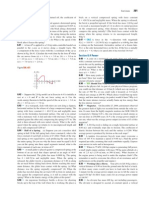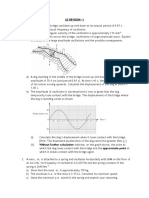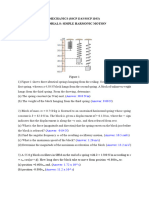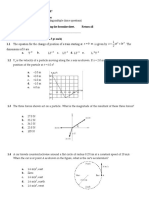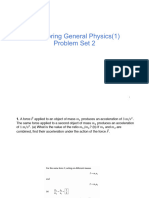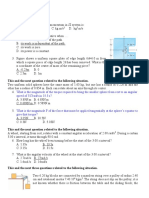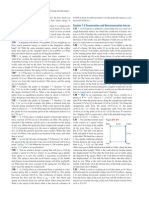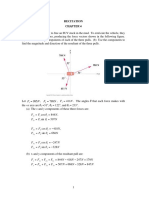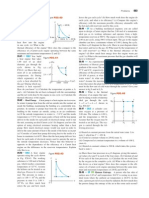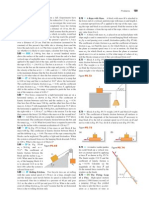Physics I Problems PDF
Physics I Problems PDF
Uploaded by
bosschellenCopyright:
Available Formats
Physics I Problems PDF
Physics I Problems PDF
Uploaded by
bosschellenOriginal Title
Copyright
Available Formats
Share this document
Did you find this document useful?
Is this content inappropriate?
Copyright:
Available Formats
Physics I Problems PDF
Physics I Problems PDF
Uploaded by
bosschellenCopyright:
Available Formats
Problems
hand to move the object slowly from x 1 to x 2. How much work do
you do? If x 2 7 x 1, is the work you do positive or negative?
(c) Explain the similarities and differences between your answers
to parts (a) and (b).
6.72 ... CALC The gravitational pull of the earth on an object is
inversely proportional to the square of the distance of the object
from the center of the earth. At the earths surface this force is
equal to the objects normal weight mg, where g = 9.8 m>s2, and
at large distances, the force is zero. If a 20,000-kg asteroid falls to
earth from a very great distance away, what will be its minimum
speed as it strikes the earths surface, and how much kinetic energy
will it impart to our planet? You can ignore the effects of the
earths atmosphere.
6.73 . CALC Varying Coefcient of Friction. A box is sliding
with a speed of 4.50 m>s on a horizontal surface when, at point P,
it encounters a rough section. On the rough section, the coefcient
of friction is not constant, but starts at 0.100 at P and increases linearly with distance past P, reaching a value of 0.600 at 12.5 m past
point P. (a) Use the workenergy theorem to nd how far this box
slides before stopping. (b) What is the coefcient of friction at the
stopping point? (c) How far would the box have slid if the friction
coefcient didnt increase but instead had the constant value of
0.100?
6.74 .. CALC Consider a spring that does not obey Hookes law
very faithfully. One end of the spring is xed. To keep the spring
stretched or compressed an amount x, a force along the x-axis with
x-component Fx = kx - bx 2 + cx 3 must be applied to the free
end. Here k = 100 N>m, b = 700 N>m2, and c = 12,000 N>m3.
Note that x 7 0 when the spring is stretched and x 6 0 when it is
compressed. (a) How much work must be done to stretch this
spring by 0.050 m from its unstretched length? (b) How much
work must be done to compress this spring by 0.050 m from its
unstretched length? (c) Is it easier to stretch or compress this
spring? Explain why in terms of the dependence of Fx on x. (Many
real springs behave qualitatively in the same way.)
6.75 .. CP A small block with a
Figure P6.75
mass of 0.0900 kg is attached to a
cord passing through a hole in a
frictionless, horizontal surface
(Fig. P6.75). The block is originally revolving at a distance of
0.40 m from the hole with a speed
of 0.70 m>s. The cord is then
pulled from below, shortening the
radius of the circle in which the
block revolves to 0.10 m. At this
new distance, the speed of the
block is observed to be 2.80 m>s. (a) What is the tension in the
cord in the original situation when the block has speed
v = 0.70 m>s? (b) What is the tension in the cord in the nal situation when the block has speed v = 2.80 m>s? (c) How much
work was done by the person who pulled on the cord?
6.76 .. CALC Proton Bombardment. A proton with mass
1.67 * 10 -27 kg is propelled at an initial speed of
3.00 * 10 5 m>s directly toward a uranium nucleus 5.00 m away.
The proton is repelled by the uranium nucleus with a force of
magnitude F = a>x 2, where x is the separation between the two
objects and a = 2.12 * 10 -26 N # m2. Assume that the uranium
nucleus remains at rest. (a) What is the speed of the proton when it
is 8.00 * 10 -10 m from the uranium nucleus? (b) As the proton
approaches the uranium nucleus, the repulsive force slows down
203
the proton until it comes momentarily to rest, after which the
proton moves away from the uranium nucleus. How close to the
uranium nucleus does the proton get? (c) What is the speed
of the proton when it is again 5.00 m away from the uranium
nucleus?
6.77 .. CP CALC A block of ice with mass 4.00 kg is initially at
rest on a frictionless,
horizontal surface. A worker then applies a
S
horizontal force F to it. As a result, the block moves along the
x-axis such that its position as a function of time is given by
x(t) = at 2 + bt 3, where a = 0.200 m>s2 and b = 0.0200 m>s3.
(a) Calculate the velocity
of the object when t = 4.00 s. (b) CalcuS
late the magnitudeS of F when t = 4.00 s. (c) Calculate the work
done by the force F during the rst 4.00 s of the motion.
6.78 .. You and your bicycle have combined mass 80.0 kg. When
you reach the base of a bridge, you are traveling along the road at
5.00 m>s (Fig. P6.78). At the top of the bridge, you have climbed a
vertical distance of 5.20 m and have slowed to 1.50 m>s. You can
ignore work done by friction and any inefciency in the bike or
your legs. (a) What is the total work done on you and your bicycle
when you go from the base to the top of the bridge? (b) How much
work have you done with the force you apply to the pedals?
Figure P6.78
m 5 80.0 kg
5.20 m
6.79 .. You are asked to design spring bumpers for the walls of a
parking garage. A freely rolling 1200-kg car moving at 0.65 m>s is
to compress the spring no more than 0.090 m before stopping.
What should be the force constant of the spring? Assume that the
spring has negligible mass.
6.80 .. The spring of a spring gun has force constant
k = 400 N>m and negligible mass. The spring is compressed
6.00 cm, and a ball with mass 0.0300 kg is placed in the horizontal
barrel against the compressed spring. The spring is then released,
and the ball is propelled out the barrel of the gun. The barrel is
6.00 cm long, so the ball leaves the barrel at the same point that it
loses contact with the spring. The gun is held so the barrel is horizontal. (a) Calculate the speed with which the ball leaves the barrel
if you can ignore friction. (b) Calculate the speed of the ball as it
leaves the barrel if a constant resisting force of 6.00 N acts on the
ball as it moves along the barrel. (c) For the situation in part (b), at
what position along the barrel does the ball have the greatest
speed, and what is that speed? (In this case, the maximum speed
does not occur at the end of the barrel.)
6.81 ... A 2.50-kg textbook is forced against a horizontal spring
of negligible mass and force constant 250 N>m, compressing
the spring a distance of 0.250 m. When released, the textbook
slides on a horizontal tabletop with coefcient of kinetic friction
You might also like
- Problems On The Osillatory MotionDocument4 pagesProblems On The Osillatory MotionAhmed RashadNo ratings yet
- Problems 15 Serway 6 eDocument16 pagesProblems 15 Serway 6 eAndre CVNo ratings yet
- All AnswersDocument22 pagesAll AnswersNadiatul JannahNo ratings yet
- Practice Test2 ps150Document3 pagesPractice Test2 ps150Antoine S. NdiayeNo ratings yet
- Tutorial 2Document3 pagesTutorial 2Muhammed IfkazNo ratings yet
- R (4.0 CM + (2.5 CM/S) I + (5.0 CM/S) T J: - (A) Find The Magnitude and Direction of The Dot's AverageDocument4 pagesR (4.0 CM + (2.5 CM/S) I + (5.0 CM/S) T J: - (A) Find The Magnitude and Direction of The Dot's AverageOlojo Oluwasegun EmmanuelNo ratings yet
- Taller 1Document4 pagesTaller 1manuelNo ratings yet
- Physics I Problems PDFDocument1 pagePhysics I Problems PDFBOSS BOSSNo ratings yet
- Physics I ProblemsDocument1 pagePhysics I ProblemsbosschellenNo ratings yet
- Physics I Problems PDFDocument1 pagePhysics I Problems PDFbosschellenNo ratings yet
- Tutorial 5Document4 pagesTutorial 5Cheryl Low100% (1)
- I-Taalem Task - Chapter 8Document3 pagesI-Taalem Task - Chapter 8ruzaimi98No ratings yet
- FHSC1014 Mechanics Tutorial 5Document3 pagesFHSC1014 Mechanics Tutorial 5许敬霖No ratings yet
- Mid Exam FisdasDocument13 pagesMid Exam FisdasipaclosefriendsNo ratings yet
- Group Work 3 For S5 MPC and MPGDocument8 pagesGroup Work 3 For S5 MPC and MPGdaniel.kamanzi1343No ratings yet
- Work Sheet@1 (2) 211119111519Document2 pagesWork Sheet@1 (2) 211119111519Bizuayehu NigatuNo ratings yet
- Physics 11Document12 pagesPhysics 11Jane100% (1)
- PHY11 Problem SetDocument24 pagesPHY11 Problem SetAlyssa AtienzaNo ratings yet
- Physics I Problems PDFDocument1 pagePhysics I Problems PDFbosschellenNo ratings yet
- Vibrations and Waves: Quick QuizzesDocument36 pagesVibrations and Waves: Quick QuizzessuryapmohantyNo ratings yet
- A2 RevisionDocument10 pagesA2 Revisiongaya8404No ratings yet
- Tutorial 8Document2 pagesTutorial 8fawwazfauzi2004No ratings yet
- Additional Problem Sheet - Fall 2022-2023 NewDocument3 pagesAdditional Problem Sheet - Fall 2022-2023 NewxdbenerobeNo ratings yet
- Fisdas1 Tugas 3 FixDocument9 pagesFisdas1 Tugas 3 FixNopran KurniawanNo ratings yet
- Final Exam W07Document5 pagesFinal Exam W07Malik ANo ratings yet
- SJPO 2016 General Round - QuestionDocument24 pagesSJPO 2016 General Round - QuestionZleepNo ratings yet
- Chapter 2 - DynamicsDocument8 pagesChapter 2 - DynamicsTHIÊN LÊ TRẦN THUẬNNo ratings yet
- 2018 June Test PrepquestionsDocument14 pages2018 June Test PrepquestionsSiinozuko MasentseNo ratings yet
- 2024spring General Physics (1) Problem Set 2 With SolutionsDocument31 pages2024spring General Physics (1) Problem Set 2 With SolutionspurevnaymbayarjargalNo ratings yet
- Physics HW 5Document2 pagesPhysics HW 5Maya HarrisNo ratings yet
- Tutoring QuestionsDocument7 pagesTutoring QuestionsJulieneNo ratings yet
- PhysDocument10 pagesPhysahmedNo ratings yet
- Ch5 Tutorial ExamplesDocument3 pagesCh5 Tutorial Exampleshappymongezimasilela12No ratings yet
- 14 - Periodic MotionDocument6 pages14 - Periodic MotionNKHICQ1mEbIwNo ratings yet
- Tutorial Ch04Document2 pagesTutorial Ch04khxrsvrgb6No ratings yet
- AL Physics/S.H.M./P.1: DX DT BXDocument4 pagesAL Physics/S.H.M./P.1: DX DT BXmiguelNo ratings yet
- Practice Hookes and SHM SolutionsDocument10 pagesPractice Hookes and SHM SolutionsZhong Huang100% (2)
- Phys B 1st Semester LBQsDocument11 pagesPhys B 1st Semester LBQsCanjiNo ratings yet
- 11 Physics Imp ch14 Marks 4Document11 pages11 Physics Imp ch14 Marks 4Parijat Deb RoyNo ratings yet
- Simple Harmonic Motion Worksheet 3: X (T) (7.8 CM) Cos (T)Document3 pagesSimple Harmonic Motion Worksheet 3: X (T) (7.8 CM) Cos (T)NadeenMohamedNo ratings yet
- ENGN 37 HomeworkDocument25 pagesENGN 37 HomeworkLucia AntoniusNo ratings yet
- CH 05Document6 pagesCH 05Mohammed Abdul MajidNo ratings yet
- Work and EnergyDocument2 pagesWork and EnergyMauricioCuellar100% (1)
- Week 2 PSC Kinematics, Vectors and Units: PHYC10001 Physics 1: AdvancedDocument3 pagesWeek 2 PSC Kinematics, Vectors and Units: PHYC10001 Physics 1: AdvancedEric HeNo ratings yet
- Revision Midterm Exam Physics1 NEWDocument14 pagesRevision Midterm Exam Physics1 NEWBá Phong LêNo ratings yet
- Physics I ProblemsDocument1 pagePhysics I ProblemsbosschellenNo ratings yet
- Chapter 3Document6 pagesChapter 3Windi Wandira100% (1)
- Sample Final Exam ProblemsDocument5 pagesSample Final Exam ProblemsDsfNo ratings yet
- Physics Problems WavesDocument3 pagesPhysics Problems WavesMalletNjonkemNo ratings yet
- Practice Exam 2 PDFDocument8 pagesPractice Exam 2 PDFDavid WeitzelNo ratings yet
- Recitation CH 4 1 CompressDocument6 pagesRecitation CH 4 1 Compressallan zenarosaNo ratings yet
- Work and Energy Prac Prob 204qiudDocument5 pagesWork and Energy Prac Prob 204qiudsaparullahNo ratings yet
- AP Physics 1 - FR Review PackageDocument10 pagesAP Physics 1 - FR Review PackageExelticNo ratings yet
- Physics I Problems PDFDocument1 pagePhysics I Problems PDFbosschellenNo ratings yet
- Introductory ProblemsDocument2 pagesIntroductory ProblemsDiego ForeroNo ratings yet
- Reviewer PhysicsDocument10 pagesReviewer PhysicsYeho ShuaNo ratings yet
- 11th SAMPLE 3. Trigonometry QuestionsDocument2 pages11th SAMPLE 3. Trigonometry Questionsrevohe2640No ratings yet
- Rev2, ENGR 62, StanfordDocument40 pagesRev2, ENGR 62, StanfordsuudsfiinNo ratings yet
- Physics I Problems PDFDocument1 pagePhysics I Problems PDFbosschellenNo ratings yet
- Physics I Problems PDFDocument1 pagePhysics I Problems PDFbosschellen0% (1)
- Physics I ProblemsDocument1 pagePhysics I ProblemsbosschellenNo ratings yet
- Physics I ProblemsDocument1 pagePhysics I ProblemsbosschellenNo ratings yet
- Physics I ProblemsDocument1 pagePhysics I ProblemsbosschellenNo ratings yet
- Physics I Problems PDFDocument1 pagePhysics I Problems PDFBOSS BOSSNo ratings yet
- Physics I ProblemsDocument1 pagePhysics I ProblemsbosschellenNo ratings yet
- Physics I Problems PDFDocument1 pagePhysics I Problems PDFbosschellenNo ratings yet
- Physics I ProblemsDocument1 pagePhysics I ProblemsbosschellenNo ratings yet
- Physics I Problems PDFDocument1 pagePhysics I Problems PDFbosschellenNo ratings yet
- Physics I Problems PDFDocument1 pagePhysics I Problems PDFbosschellenNo ratings yet
- Physics I ProblemsDocument1 pagePhysics I ProblemsbosschellenNo ratings yet
- Physics I Problems PDFDocument1 pagePhysics I Problems PDFbosschellenNo ratings yet
- Physics I Problems PDFDocument1 pagePhysics I Problems PDFbosschellenNo ratings yet
- Physics I Problems PDFDocument1 pagePhysics I Problems PDFbosschellenNo ratings yet
- Physics I Problems PDFDocument1 pagePhysics I Problems PDFbosschellenNo ratings yet
- Physics I Problems PDFDocument1 pagePhysics I Problems PDFbosschellenNo ratings yet
- Physics I Problems PDFDocument1 pagePhysics I Problems PDFbosschellenNo ratings yet
- Physics I Problems PDFDocument1 pagePhysics I Problems PDFbosschellenNo ratings yet
- Physics I Problems PDFDocument1 pagePhysics I Problems PDFbosschellenNo ratings yet
- Physics I Problems PDFDocument1 pagePhysics I Problems PDFbosschellenNo ratings yet
- Physics I Problems PDFDocument1 pagePhysics I Problems PDFbosschellenNo ratings yet
- Physics I ProblemsDocument1 pagePhysics I ProblemsbosschellenNo ratings yet
- Physics I ProblemsDocument1 pagePhysics I ProblemsbosschellenNo ratings yet
- Physics I Problems PDFDocument1 pagePhysics I Problems PDFbosschellenNo ratings yet
- Physics I Problems PDFDocument1 pagePhysics I Problems PDFbosschellenNo ratings yet
- Physics I Problems PDFDocument1 pagePhysics I Problems PDFbosschellenNo ratings yet
- Physics I Problems PDFDocument1 pagePhysics I Problems PDFbosschellenNo ratings yet
- Physics I Problems PDFDocument1 pagePhysics I Problems PDFbosschellenNo ratings yet
- Physics I Problems PDFDocument1 pagePhysics I Problems PDFbosschellenNo ratings yet
- Wa0000Document231 pagesWa0000Nikesh MoreNo ratings yet
- Thermodynamics of Phase Transitions: 3.A. 3.B. 3.C. 3.D. 3.E. 3.F. 3.G. 3.HDocument49 pagesThermodynamics of Phase Transitions: 3.A. 3.B. 3.C. 3.D. 3.E. 3.F. 3.G. 3.HAnonymous 4nyKDmNo ratings yet
- Unit 2 KinematicsDocument94 pagesUnit 2 KinematicsOsama AbdullahNo ratings yet
- Periodical Test in Math 4th PcesDocument8 pagesPeriodical Test in Math 4th PcesDanielLarryAquinoNo ratings yet
- Gauss Law ApplicationDocument14 pagesGauss Law Applicationjerin123No ratings yet
- Q. 5 in The Following Circuit The Resultant Capacitance Between A and B Is I F. Find The Value of C (Ans F)Document12 pagesQ. 5 in The Following Circuit The Resultant Capacitance Between A and B Is I F. Find The Value of C (Ans F)dilip kumarNo ratings yet
- Fourier Series PresentationDocument22 pagesFourier Series PresentationÊãglê Ēyês100% (1)
- BSc-Phys-Hon-CBCS (2020) PDFDocument139 pagesBSc-Phys-Hon-CBCS (2020) PDFBikash DeyNo ratings yet
- Science Behind Eddy Current and Remote Field Testing Condenser and Heat Exchanger TubingDocument6 pagesScience Behind Eddy Current and Remote Field Testing Condenser and Heat Exchanger Tubingantant3052No ratings yet
- Natural Convection in A Parall L-Plate CH NN 10.3.1 TH El Nbaa Correlation 10.3Document3 pagesNatural Convection in A Parall L-Plate CH NN 10.3.1 TH El Nbaa Correlation 10.3JojiNo ratings yet
- MORSEL 20 (Fluid Statics)Document4 pagesMORSEL 20 (Fluid Statics)Lalitha RamakrishnanNo ratings yet
- Network Analysis Notes CompiledDocument50 pagesNetwork Analysis Notes CompiledmaruthinmdcNo ratings yet
- Barnett DevelopmentConceptHeatI 1946Document9 pagesBarnett DevelopmentConceptHeatI 1946asddassdNo ratings yet
- MCQs in Microwave Communications Part IDocument10 pagesMCQs in Microwave Communications Part IRaghu Veer KNo ratings yet
- Newton's Law of CoolingDocument6 pagesNewton's Law of CoolingsomeoneveryrandomNo ratings yet
- Advance Structural Dynamics: HomeworkDocument27 pagesAdvance Structural Dynamics: HomeworkAlin NegarăNo ratings yet
- Fanning Friction FactorDocument1 pageFanning Friction Factorrelicario25No ratings yet
- Quantum Mechanical Particle in A Box: V X X V A X N H N E K A N NDocument4 pagesQuantum Mechanical Particle in A Box: V X X V A X N H N E K A N Nreksy_wibowoNo ratings yet
- Analysis Piecewise Function Using Velocity and Time in MatlabDocument4 pagesAnalysis Piecewise Function Using Velocity and Time in Matlabrista fitriNo ratings yet
- The Cosmological Constant Stephen HawkingDocument9 pagesThe Cosmological Constant Stephen HawkingikutmilisNo ratings yet
- Lecture Notes in PhysicsDocument12 pagesLecture Notes in Physicsaslı tuncerNo ratings yet
- Camposelectromagnéticos PDFDocument468 pagesCamposelectromagnéticos PDFPercy SabyNo ratings yet
- Physics 1120: Work & Energy Solutions: NC Grav F Spring I 2Document27 pagesPhysics 1120: Work & Energy Solutions: NC Grav F Spring I 2Sundly Talorong ElerioNo ratings yet
- Centre of Mass and System of Particles, Collision _ Practice Sheet __ Yakeen NEET 2.0 2025 (Legend)Document8 pagesCentre of Mass and System of Particles, Collision _ Practice Sheet __ Yakeen NEET 2.0 2025 (Legend)Prabhat KatariyaNo ratings yet
- Science 4 Quarter 3 Module 1 2 Chennee Rose G. Reyes Donna G. SanchezDocument13 pagesScience 4 Quarter 3 Module 1 2 Chennee Rose G. Reyes Donna G. SanchezFrit ZieNo ratings yet
- Quotes Thomas HobbesDocument9 pagesQuotes Thomas HobbesKarl SampangNo ratings yet
- Introduction To Nitride Semiconductor Blue Lasers and Light Emitting Diodes 0748408363Document386 pagesIntroduction To Nitride Semiconductor Blue Lasers and Light Emitting Diodes 0748408363titsbhiwaniNo ratings yet
- Power Capacitor Handbook, Longland, Hunt, BecknellDocument161 pagesPower Capacitor Handbook, Longland, Hunt, BecknellPaulo H Tavares100% (4)
- Shreyas VedantuDocument59 pagesShreyas VedantuDharshan PGNo ratings yet
- IB Chemistry - SL Topic 6 Questions 1Document21 pagesIB Chemistry - SL Topic 6 Questions 1Jonathon Hart100% (1)








